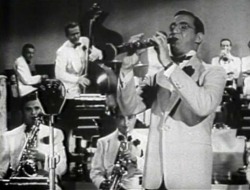Big Band and Western Swing (An Introduction)

The origins of jazz can be traced in the late Nineteenth century to the plantations of the Southern USA, the streets of America's cities, and from two distinct musical traditions, those of West Africa and Europe. West Africa provided the incessant rhythmic drive, but the European influence had more to do with classical qualities of harmony and melody.
Although New Orleans is credited as being the centre for Jazz in the early 20 th century, the music really took off in the early 1920s, when trumpeter Louis Armstrong left New Orleans to create a revolutionary new music in Chicago. This was followed by a movement of musicians to Chicago and New York bringing a permanent shift from South to North.
The early bands of the Swing Era emerged on the scene in the early '20s, and credit for the beginnings of the big band era must go to leader-arranger Fletcher Henderson, who somewhat enlarged the small combo bands into bigger ensembles. By establishing sections of trumpets, trombones, saxophones and rhythm, Henderson and other arrangers were able to create music of greater colour, range, texture and power.
Big band became the popular music of its day, hitting its peak in the mid 1930s. Well-known bandleaders like Duke Ellington, Count Basie, Chick Webb, Benny Goodman, Charlie Barnet, Jimmy Lunceford and Glenn Miller wrote and recorded a virtual parade of hit tunes that were played not only on radio but in dancehalls everywhere.
FLETCHER HENDERSON
Fletcher Henderson was born in Cuthbert, GA to a father, a former slave who was freed by General Sherman during the Civil War and who went on to become an educator during Reconstruction. He attended Clark College in Atlanta and graduated in 1920, where he was a member of Alpha Phi Alpha, the first intercollegiate Greek-letter organization established for African Americans. He later attended Columbia University in New York and was awarded a Masters in Chemistry. 1922 found Henderson forming his own band, which was resident first at the Club Alabam then at the Roseland, and quickly became known as the best "Black" band in New York. For a time his ideas of arrangement were heavily influenced by those of Paul Whiteman but when Louis Armstrong joined his orchestra in 1924 Henderson realized there could be a much richer potential for jazz band orchestration.
WESTERN SWING
Western Swing originated in the dance halls of small towns throughout the Lower Great Plains in the 1920s and 1930sevolving from the old house parties and ranch dances where fiddlers and guitarists entertained dancers. According to guitarist Merle Travis, Western Swing is nothing more than a group of talented country boys, unchsooled in music, but playing the music they feel, beating a solid two-four rhythm to the harmonies that buzz around their brains. When it escapes in all it musical glory, my friend, you have Western Swing. During the early developmental phase an uncordinated but parallel progression occurred with scores of groups from San Antoinio to Shreveport to Oklahoma City playing different repetories with same basic sound.
Western Swing reached its "golden age" during the years preceding WWII, blossomed on the West Coast during the war, and was extremely popular throughout the West. In the 1940s the Light Crust Doughboys broadcasts went out over 170 radio stations in the South and Southwest, and were heard by millions of people.
*Benny Goodman *Duke Ellington * Jimmy Lunceford *Bob Wills
